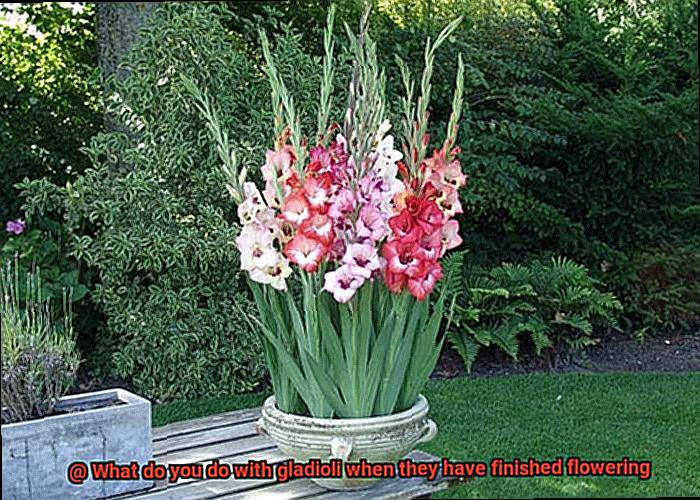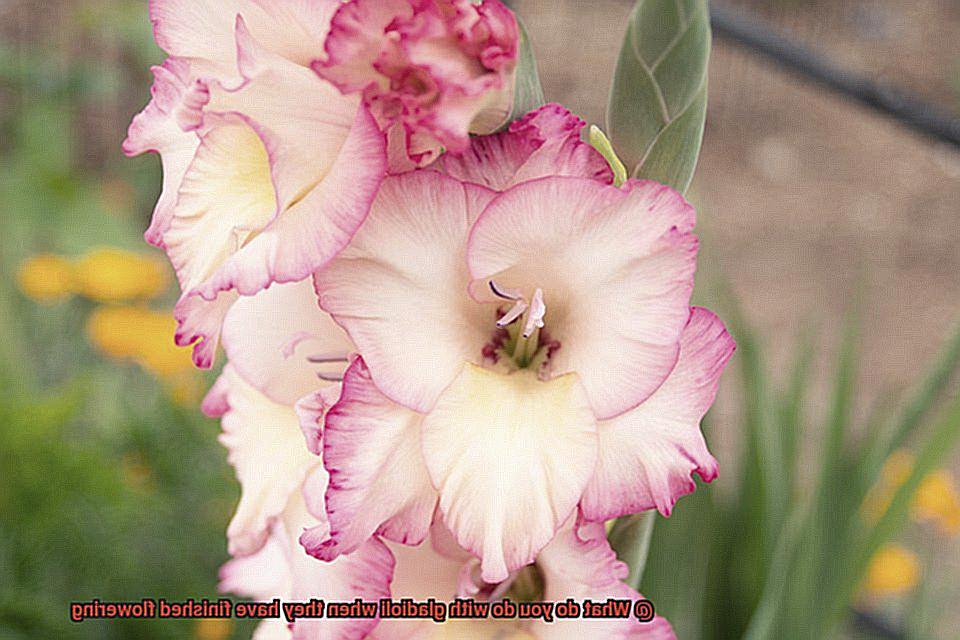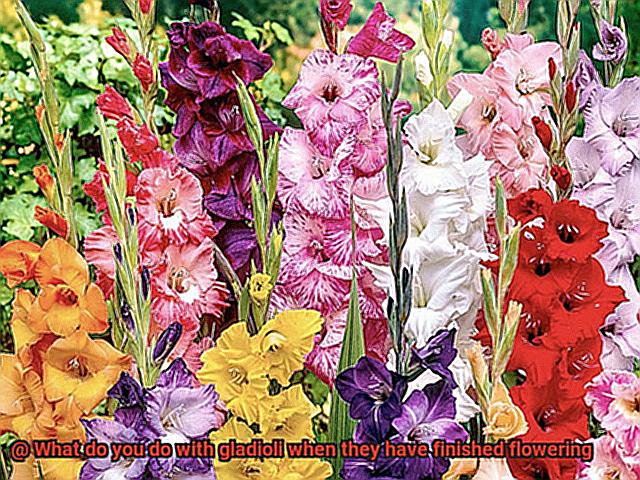Do you take pride in your backyard’s colorful display of gladioli? These sword lilies are a popular addition to any landscape, boasting a variety of vibrant hues. However, like most flowering plants, gladioli come with an expiration date. So, what should you do when your gladioli have finished blooming?
Some gardeners may be tempted to toss out the bulbs, but hold on. Did you know that gladioli bulbs can be stored and reused for the next growing season? With proper care and attention, you can enjoy a fresh display of gladioli blooms year after year.
In this post, we’ll explore the process of storing gladioli bulbs and explain how to properly care for them once the blooming season has ended. From digging up the bulbs to removing debris and preparing for storage, we’ve got you covered. So if you’re eager to make the most out of your gladioli investment and witness their beauty time and time again, keep reading.
What are Gladioli?
Contents
Gladioli, also known as sword lilies, are an absolutely gorgeous type of flowering plant that belongs to the iris family. With their tall, showy spikes of colorful flowers, gladioli have become a popular choice for gardeners and floral enthusiasts alike.
Originating from South Africa, gladioli can grow up to 4 feet tall and come in a variety of stunning colors such as pink, red, yellow, orange, and white. Their name derives from the Latin word “gladius,” which means sword. This is because their leaves resemble swords while the flowers themselves are made up of six petals and a central trumpet-shaped structure called the throat.
One of the most impressive aspects of gladioli is their long vase life. These beautiful flowers can last for weeks and are commonly used in floral arrangements as cut flowers. Gladioli can bring a pop of color and elegance to any space with ease.
In addition to being ornamental, gladioli also have practical uses once they have finished flowering. The leaves and stems contain valuable nutrients that can enrich the soil, making them an eco-friendly option for composting. To compost gladioli, simply remove the corm (the bulb-like structure at the base of the plant) along with any remaining flowers or foliage. These can be added to a compost pile or bin along with other organic matter like food scraps and yard waste.
If you prefer not to compost or use gladioli as cut flowers, it’s best to let them die back naturally. As the leaves and stems wither and dry out, they will eventually fall off on their own. This natural process helps return nutrients back into the soil.
It’s important to note that disposing of gladioli in the trash is not an ideal option as it contributes to landfill waste and pollution. By composting or using them as cut flowers, we can give them a second life while also being mindful of the environment.
Composting Gladioli
If you’re a fan of gladioli, you know they’re not just a pretty face. After flowering, their leaves and stems can be composted into a valuable source of organic matter for your garden. Composting gladioli is an eco-friendly option that enriches the soil with nutrients and reduces waste. In this post, I’ll walk you through the process and share some tips for successful composting.
First things first: remove the spent blooms from the stem and toss them into a compost bin. Mix them with other organic matter like leaves, grass clippings, and food waste. But don’t add the bulbs to the compost bin. Save them for replanting in the future, or give them away to other gardeners.
To create a balanced compost pile, mix your gladioli blooms with other organic matter. This will ensure proper decomposition without getting too wet or too dry. Regularly turning the compost pile will speed up the process, making it ready for use sooner.
The magic of composting comes from mixing different materials. By combining gladioli blooms with other organic matter, you create an environment that’s rich in diversity and perfect for microorganisms to break down materials quickly and efficiently. Mixing different materials also helps balance the carbon-to-nitrogen ratio needed for healthy composting.
Once your compost has fully decomposed, spread it around your plants as a natural fertilizer. Your garden will thank you for the added nutrients from the decomposed organic matter, keeping your plants healthy and thriving.
Using Gladioli as Cut Flowers
Gladioli are the perfect cut flowers for those who want to add a touch of elegance and color to their home or event. With their long stems and radiant hues, it’s no surprise that they are a popular choice for floral arrangements. However, to ensure that your gladioli remain fresh and stunning for as long as possible, proper care is essential.
The first step in preparing your gladioli as cut flowers is to cut the stems at an angle. Doing so will help the flowers absorb water more easily, which is crucial for their longevity. Additionally, it’s essential to strip any leaves that will be below the waterline to prevent bacteria growth in the vase.
To keep your gladioli fresh, place them in a vase with clean water and floral preservative. Not only do floral preservatives contain nutrients that help the flowers stay fresh longer, but they also contain bactericides that prevent bacteria growth in the water. To ensure proper water absorption and freshness, change the water every few days and recut the stems.
When arranging your gladioli, don’t be afraid to get creative. Gladioli are best suited for tall vases or containers due to their long stems. They can be arranged alone or paired with other flowers for a stunning mixed bouquet that will brighten up any room.
Once your gladioli have finished flowering, they can be composted along with other organic materials. Alternatively, you can dig up the bulbs and store them for planting in the following season. However, it’s important to allow the leaves to yellow and die back naturally before digging up the bulbs. This ensures that they have stored enough energy for next year’s growth.
Letting Gladioli Die Back Naturally
Fear not, letting them die back naturally is a great option for maintaining their health and beauty.
When you let your gladioli die back naturally, you allow the plant to continue growing until it withers and turns brown on its own. This process is essential for the plant’s health because it absorbs nutrients from the leaves and stores them in the bulb for next year’s growth. If you cut the plant too early, you risk preventing this nutrient absorption, resulting in a weaker plant next year.
To let gladioli die back naturally, simply stop watering the plant once the flowers have died. Allow the foliage to continue growing until it begins to yellow and brown. Once this happens, you can cut back the stems to about 3-4 inches above the ground.
It’s important to resist the urge to cut back the foliage too soon, even though it may not look as pretty as it did during its flowering period. Cutting it too early can negatively impact the health of the plant for future years, so patience is key.
By letting your gladioli die back naturally, not only are you allowing the plant to properly absorb nutrients for next year’s growth, but you’re also promoting a more sustainable and environmentally friendly approach by letting nature take its course.
Disposing of Gladioli in the Trash
Properly disposing of gladioli in the trash is crucial to prevent the spread of any remaining bulbs or seeds in the landfill. Lucky for you, it’s a simple process that can be done in a few easy steps.
First and foremost, it’s vital to wait until the flowers have completely withered and died before disposing of them. This ensures that any remaining seeds or bulbs have fully developed, making them less likely to spread in the landfill. Once this has happened, it’s time to move on to step two.
Using sharp shears, cut off the gladioli flowers at the stem and place them in a plastic bag for disposal. Be sure to tie the bag tightly, so stray petals don’t escape during transportation. For step three, place the bag into your regular trash bin for pickup. It’s essential to note that composting gladioli flowers isn’t recommended unless you have a large-scale composting operation that can handle the high nitrogen content of the flowers.
Lastly, it’s always a good idea to check with your local waste management agency for any specific regulations or guidelines for disposing of plant materials in the trash. By following these simple steps, you can ensure safe and responsible disposal of your gladioli flowers.

Benefits of Reusing and Recycling Gladioli

Not only can it save you money, but it can also contribute to a more sustainable lifestyle while reducing waste.
Let’s start with reusing gladioli bulbs. Instead of buying new ones each year, why not reuse old bulbs? It’s easy to do and will reduce waste while saving you money. Simply dig up the bulbs when they’re completely dead, clean them off, and store them in a cool, dry place until you’re ready to plant them again.
Want to know another benefit of reusing gladioli bulbs? It can improve soil health. When you break apart the old bulbs and add them to your soil or compost pile, they provide nutrients for other plants. This reduces the need for synthetic fertilizers that can harm the environment.
But wait, there’s more. Recycling gladioli flowers is another way to repurpose materials and reduce waste. The long stems and colorful petals are perfect for making floral arrangements, wreaths, or even pressed flower art. Not only will this add beauty to your home or event space, but it will also help reduce waste.
Finally, reusing and recycling gladioli can contribute to a sustainable lifestyle. By taking steps to reduce waste and repurpose materials, we are making a positive impact on our planet. By sharing your efforts with others, you might inspire them to do the same.
DxS2Az3JxUI” >
Conclusion
To sum it up, gladioli are a stunning addition to any floral display or garden. But what happens when they’ve bloomed their last? Don’t be quick to throw them away. There are plenty of ways to give these beauties a second life while also being eco-friendly and cost-effective.
One option is composting the leaves and stems of gladioli after they’ve naturally died back. This not only enriches the soil with valuable nutrients but also reduces waste. Another way is to extend their lifespan as cut flowers by providing them with clean water and floral preservatives. And once they’re done flowering, you can dig up the bulbs and store them for planting next season.
It’s crucial to note that disposing of gladioli in the trash isn’t ideal as it contributes to landfill waste and pollution. Instead, consider composting or repurposing them as cut flowers. By doing so, you’re not only giving them a new purpose but also being mindful of our planet.
Reusing and recycling gladioli has numerous benefits, including improving soil health, reducing synthetic fertilizer usage, adding beauty to your home or event space, and making a positive impact on our environment. So before tossing out your finished gladioli, think about these options first.





